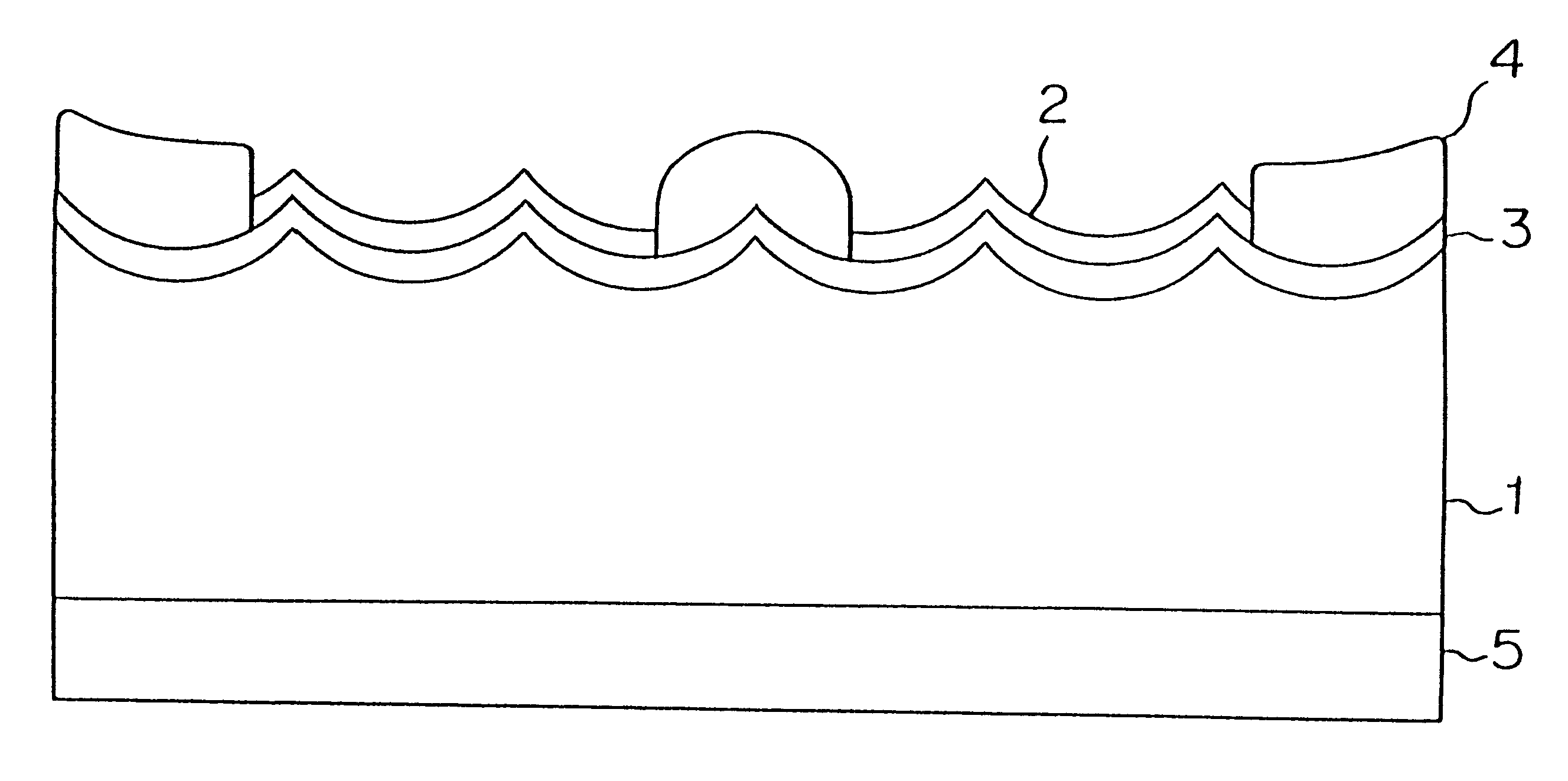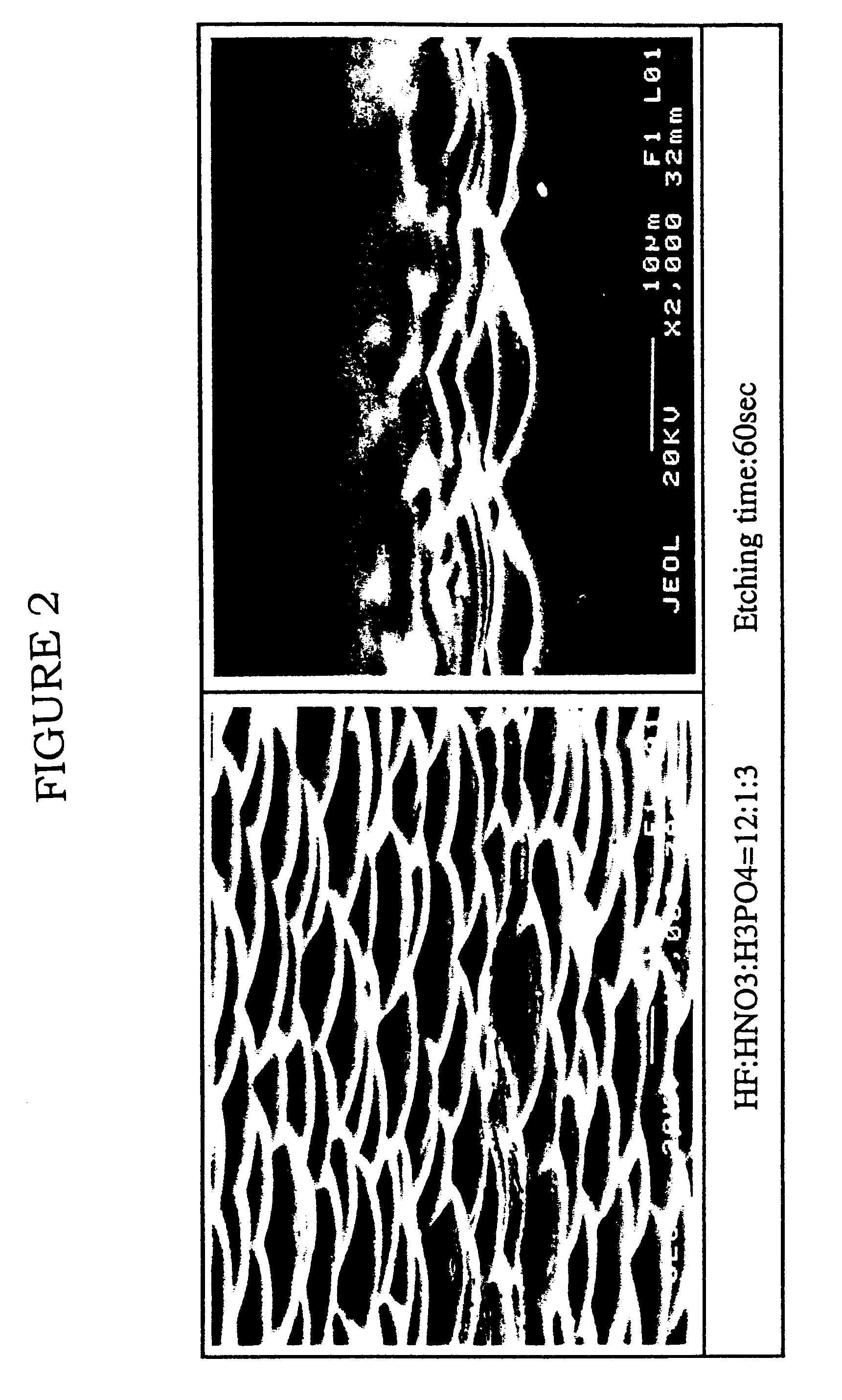Solar cell, a method of producing the same and a semiconductor producing apparatus
a solar cell and production method technology, applied in the field of solar cells of high efficiency, a method of producing the same and an apparatus for producing a semiconductor, can solve the problems of preventing the formation of effective electrodes, utilizing a difference in etching rate at crystal planes, and not providing an antireflection
- Summary
- Abstract
- Description
- Claims
- Application Information
AI Technical Summary
Problems solved by technology
Method used
Image
Examples
embodiment 2
An example of a method of producing a solar cell in which a surface active agent is added (in about 580 ppm) into an etching liquid of mixed acid containing hydrofluoric acid, nitric acid and phosphoric acid as major components, will be described.
An etching liquid of mixed acid comprising a 50% hydrofluoric acid, a 69% nitric acid and a 85% phosphoric acid in the proportions of 12 parts by volume, 1 part by volume and 12 parts by volume is prepared, and an nonionic surface active agent of about 580 ppm is added thereto. A cast silicon substrate is dipped in the etching liquid of mixed acid for a time sufficient to obtain a predetermined etching quantity while the liquid is maintained at the room temperature. After the etching, the substrate is quickly taken out from the etching liquid and is transferred to a water tank filled with washing water in which washing is conducted by continuously supplying water to remove the etching liquid on the substrate. If a brown or black colored dep...
embodiment 3
An etching liquid of mixed acid comprising a 50% hydrofluoric acid, a 69% nitric acid and a 85% phosphoric acid in the proportions of 12 parts by volume, 1 part by volume and 12 parts by volume is prepared, and a nonionic surface active agent of about 580 ppm is added thereto. Further, ammonium fluoride of 30 g / l is added to the mixture. Then, a cast silicon substrate is dipped in the mixed etching liquid for a time to obtain a predetermined etching quantity while the liquid is kept at room temperature. After the etching, the substrate is quickly taken out from the liquid, and is transferred into a water tank filled with washing water in which washing is conducted by continuously supplying water to wash out the etching liquid on the substrate. However, if a brown or black-colored deposit remains on the substrate surface thus treated, the substrate is dipped in an aqueous solution of caustic soda or caustic potash having a concentration of several % to several ten % for several secon...
embodiment 4
An example of producing a solar cell by using a substrate wherein a minute projection / recess structure is formed in the surface according to the method described in Embodiment 2, will be explained.
FIG. 8 is a cross-sectional view of an embodiment of the solar cell according to the present invention wherein numeral 1 designates a silicon substrate, numeral 2 designates an antireflection film formed on a plane to which light is incident, numeral 3 designates a n.sup.+ diffusion layer, numeral 4 designates a grid-like n electrode formed by sintering a silver paste, and numeral 5 designates a p electrode formed on a rear plane by sintering an aluminum paste or an aluminum-silver paste.
The p type polycrystal silicon substrate 1 in which a minute projection / recess structure was formed as described in Embodiment 2 was put in a diffusion furnace in which phosphorous oxychloride (POCl.sub.3) was used as a diffusion source, and phosphorous (P) was diffused by a vapor phase reaction to thereby...
PUM
 Login to View More
Login to View More Abstract
Description
Claims
Application Information
 Login to View More
Login to View More - R&D
- Intellectual Property
- Life Sciences
- Materials
- Tech Scout
- Unparalleled Data Quality
- Higher Quality Content
- 60% Fewer Hallucinations
Browse by: Latest US Patents, China's latest patents, Technical Efficacy Thesaurus, Application Domain, Technology Topic, Popular Technical Reports.
© 2025 PatSnap. All rights reserved.Legal|Privacy policy|Modern Slavery Act Transparency Statement|Sitemap|About US| Contact US: help@patsnap.com



